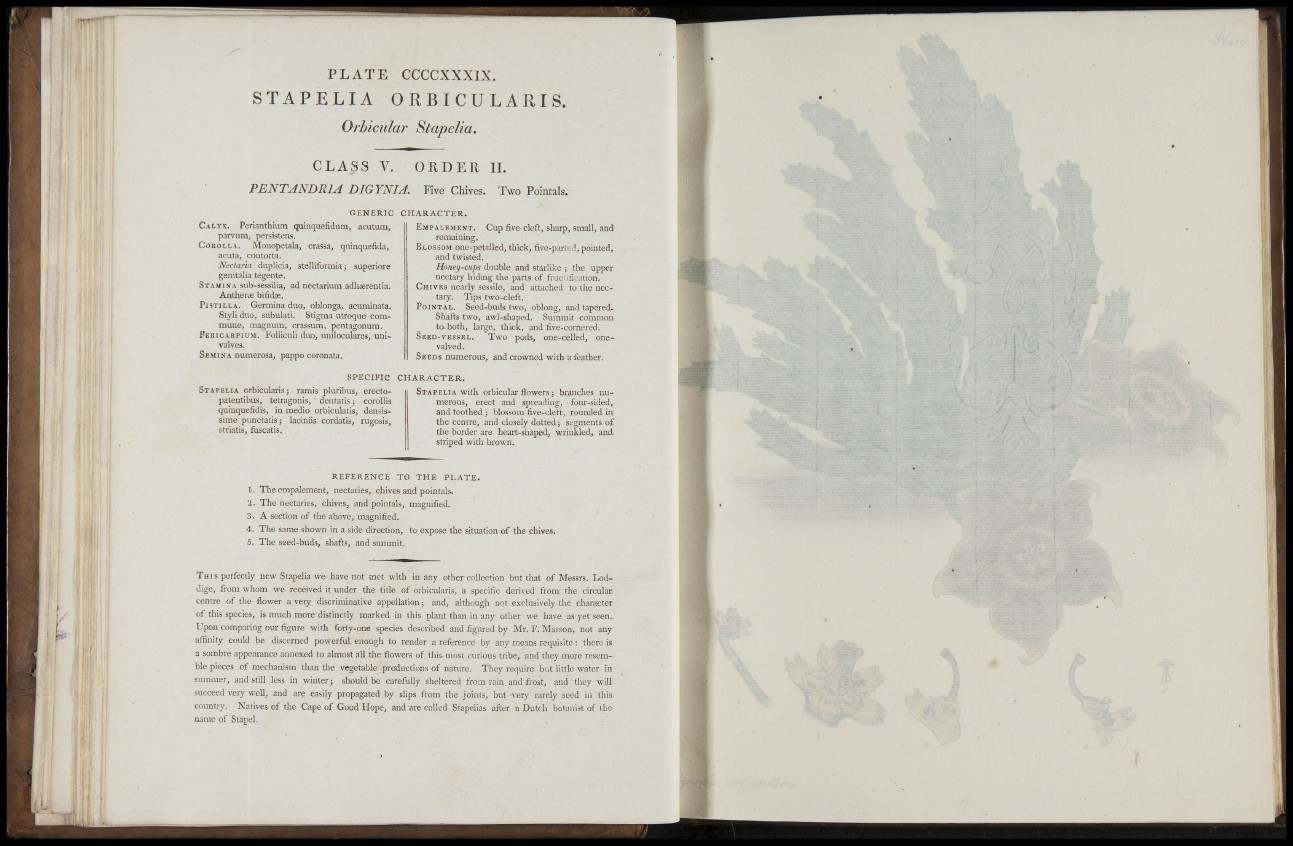
A
f f
••fl
Ii
i .
P L A T E CCCCXXXIX.
S T A P E L I A ORBICULARIS.
Orbicular Stapelia.
CLASS V. ORDER IL
P E N T A N D R I A DIGYNIA. Five Chives. Two Pointais.
GENERIC
CALYK. Perianthlura quinquefidum, acutum,
parvum, perststens.
COROLLA. Mouopetala, crassa, quinquefida,
acuta, coutorta.
Nectaria duplicia, stelliforcnia ; superiore
genitalia tegente.
STAMINA sub-sessilia, ad nectarium adhaereutia.
Antlierae bifidae.
PiSTiLLA. Germina duo, oblonga, acuminata.
Styli duo, subulati. Stigma utroque commune,
magnum, crassum, pentagonum.
PEKICARPIUM. Folliculi duo, uniloculares, univalves.
S E M I N A numerosa, pappo coronata.
CHARACTER.
EMPALEMENT. Cup five-cleft, sharp, small, and
remaining.
BLOSSOM one-petalled, thick, five-parted, pointed,
and twisted.
Honey-cups double and starlike ; the upper
nectary hiding the parts of fradification.
C H I V E S nearly sessile, and attached to the nectary.
Tips two-cleft.
PoiNTAL. Seed-buds two, oblong, and tapered.
Shafts two, awl-shaped. Summit common
to both, large, thiclc, and five-cornered.
S E E D - V E S S E L . Two pods, one-celled, onevalved.
SEED S numerous, and crowned with a feather.
SPECIFIC CHARACTER.
S T A P E L I A orbicularis; ramis pluribus, erectopatentibus,
tetragonis, dentatis ; corollis
quinquefidis, in medio orbiculatis, densissime
punctatis ; laciniis cordatis, rugosis,.
striatis, fuscatis.
S T A P E L I A with orbicular flowers; branches numerous,
erect and spreading, four-sided,
and toothed ; blossom five-cleft, rounded in
the centre, and closely dotted; segments of
tlie border are heart-shaped, wrinkled, and
striped with brown..
REFERENCE TO THE PLATE.
1. The empalement, nectaries, chives and pointais.
2. The nectaries, chives, and pointais, magnified.
3. A section of tlie above, magnified.
4. The same shown in a side direction, to expose tlie situation of the chives.
5. The seed-buds, shafts, and summit.
T H I S perfectly new Stapelia we have not met with in any other-collection but that of Messrs. Lod-
Jige, from whom we received it under the title of orbicularis, a specific derived from the circular,
centre of the flower a very discriminative appellation; and, although not exclusively the character
of this species, is much more distinctly marked in this plant than in any other we have as yet seen..
Upon comparing our figure with forty-one species described and figured by Mr. F. Masson, not any
affinity could be discerned powerful enough to render a reference by any means requisite: there is
a sombre appearance annexed to almost all tlie flowers of this, most curious tribe, and they more resemble
pieces of mechanism than tlie vegetable productions of naUire. They require but little water in
summer, and still less in winter; should be carefully sheltered from rain and frost, and they will
succeed very well, and are easily propagated by slips from the joints, but -very rarely seed in this,
country. Natives of the Cape of Good Hope, and are called Slapelias after a Dutch botanist of the
aanie of Stapel,
• -.^.„.LI